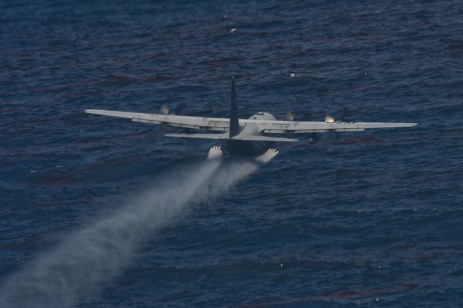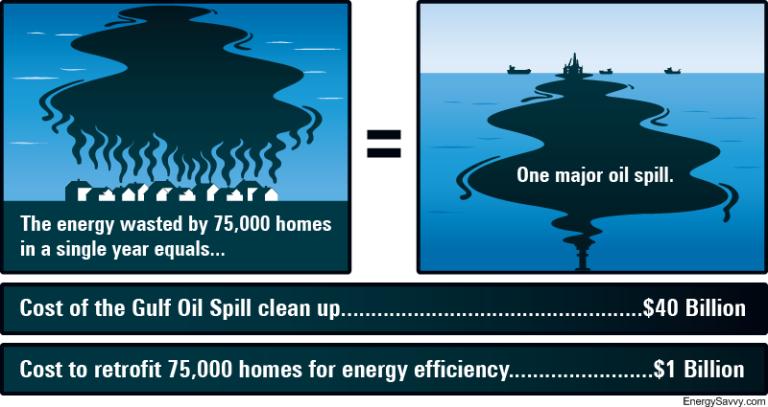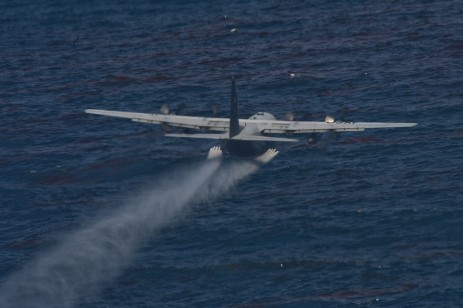 As of June 9, BP had applied at least 1.1 million gallons of toxic chemical dispersants to address its ongoing oil leak in the Gulf. That’s the most that has been used in one place since 1979, when the Mexican government dropped between 1 million and 2.5 million gallons on a leak off the coast of Vera Cruz, the EPA reports.
As of June 9, BP had applied at least 1.1 million gallons of toxic chemical dispersants to address its ongoing oil leak in the Gulf. That’s the most that has been used in one place since 1979, when the Mexican government dropped between 1 million and 2.5 million gallons on a leak off the coast of Vera Cruz, the EPA reports.
As I reported in early May, the dispersant products, branded Corexit 9527A and Corexit 9500A, were made exclusively by a former Exxon subsidiary now owned by a company called Nalco. Exxon researchers had already acknowledged that they were significantly toxic for aquatic life. But just how toxic was mysterious — particularly for humans. The publicly available data sheets for both products revealed that they have the “potential to bioconcentrate,” but added this stunner: “No toxicity studies have been conducted on this product.”
Information about their precise composition was also vague, clouded by a veil of secrecy based on “proprietary” concerns. I found the information scarcity outrageous. A private company fouls a vast public resource and then dumps hundreds of thousands of gallons of a toxic chemical potion into it. Doesn’t the public have the right to know precisely what’s in that potion?
To me, the real culprit in the dispersants story wasn’t BP or Nalco. Those companies are beholden to their shareholders to maximize profit. BP is working frantically to limit its liability from an ecological snafu of nearly bottomless proportions. Keeping as much oil off of shorelines and underwater, where its damage is hard to quantify, serves the company’s economic interests. As for Nalco, its chief interest is to move product. Releasing precise information about its dispersants evidently works against that goal.
The real culprits in the dispersants affair, I argued, were the federal agencies overseeing the spill response: NOAA and EPA. They are duty-bound to protect the public and the Gulf ecosystem. Rather than cowering to the side, fretting about “proprietary” considerations, they should have been demanding Corexit samples and performing or commissioning studies. And if Nalco refused to hand over samples, the federal watchdogs should have bared their teeth and sued.
Even if the companies managed to fight off the challenges in court, they’d be exposing themselves to a potential PR firestorm — and likely be shamed into behaving decently.
After my initial burst of reporting, I spent a week in California at the end of May, got immersed in other things, and lost track of the story. Honestly, I assumed that with increasing media attention, the EPA and NOAA would wrestle control over dispersant use from BP and impose a rational policy.
Memo to self: Don’t be so naive ever again. The Public Radio International show “Living on Earth” reports that Nalco still won’t release Corexit samples to independent researchers. LOE staff talked to no fewer than five university-based scientists who have been denied access to Corexit. These people are trying to answer critical questions: When you combine Corexit with crude oil in a seawater medium, how does the resulting mixture behave? How quickly does it dissipate? How much oxygen does its decomposition tie up, potentially making life inhospitable to marine life? How does the toxicity of the oil/Corexit mixture compare to that of the individual components? And so on.
University of Georgia marine sciences professor Samantha Joye had this to say:
In terms of understanding the impacts of dispersants on microbial activity I and many others are still trying to get samples of the various dispersants that are being used. I’ve been unable to secure any so far.
Added toxicology professor Ron Kendall, who directs the Institute of Environmental and Human Health at Texas Tech University:
We attempted to acquire the Corexit from the manufacturer and basically were given a roadblock and have not been able to obtain it.
Meanwhile, as Nalco stonewalls independent researchers, the EPA is evidently getting quite worried about the toxicity of the dispersants — and BP is brazenly ignoring the agency’s requests on their use.
First, back on May 20, there was this widely reported EPA “directive” for BP to “identify and use a less toxic and more effective dispersant from the list of EPA authorized dispersants.” BP responded like a spoiled teenager shurgging off an empty parental threat. The answer, in a word: no.
And now, according to Brad Johnson of the Wonk Room, BP is brazenly ignoring explicit EPA requests on dispersant use. Johnson points to yet another EPA directive, this one demanding that the company “eliminate the surface application of dispersants” and limit subsea applications to “not more than 15,000 gallons in a single calendar day,” with a goal to reducing daily use to 75 percent of that low rate.
In other words, the EPA is calling for the near elimination of dispersants as a tool for addressing the spill — evidence that the agency is highly skeptical of their benefits. And BP’s response? Wonk Room’s Johnson reports:
A Wonk Room analysis of information released by the oil disaster command center found that the May 26 directive has not been followed — 120,000 gallons of dispersant have been used at the surface, total use is only down by 25 percent, and on Sunday, June 6, BP used 33,000 gallons of subsea dispersant, more than twice the allowed amount.
Confronted about the disobedience, Johnson reports, the EPA responded that BP personnel “blamed ‘mechanical difficulties’ but do not expect it to happen again.'”
“Mechanical difficulties”? Sorry, that’s hollow. It might have made sense a week after the “directive.” Two weeks after, not so much.
As Tim Dickinson’s Rolling Stone exposé (summarized here) shows in depressing detail, the Obama administration has proved unable to stand up to the oil industry on matters of substance both before and after the Deepwater blowout. (The administration’s craven acceptance of BP’s policy of passing on clearly false “estimates” of the leak rate are just one example.) In addition to the ConocoPhillips director now co-leading the administration’s investigation of the disaster, the administration last year plucked no fewer than two execs from longtime perches at BP and gave them high positions in the Department of Energy and the Mineral Mining Services.
If Obama wants to credibly declare independence from the industry and show he’s serious about shifting from oil to cleaner sources, wresting control over the dispersants issue from BP would make a good start.




